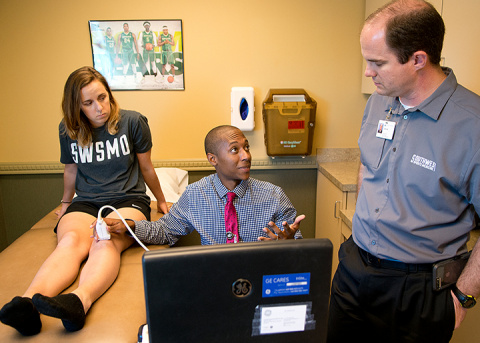
Editor’s note: After careful consideration, the Master Preceptor Program was sunsetted by NATA in 2025. Learn more about NATA’s educational offerings.
An athletic training preceptor is an important part of the education process for athletic training students. By the AT Strategic Alliance’s definition, “preceptors supervise and engage students in clinical education.” An athletic training preceptor is undoubtedly an important part of the education process for AT students, but it can be equally important for preceptors themselves to improve.
Drew Duckett, MS, ATC, preceptor-at-large on the NATA Professional Education Committee, said as the educational landscape continues to transform, opportunities for preceptors to increase their own training or improve process should be considered as preceptors are still vital in shaping future athletic trainers.
Duckett sees the definition of preceptor as much more nuanced, and their role should not be considered secondary to, or lesser than, a full-time job. The role of a preceptor, he said, has an even greater impact on students as curriculum standards of athletic training education now require some level of immersion.
“Being a teacher is much different than just showing someone how to do something. … Teaching is to impart knowledge while instruction is to impart skills,” Duckett said. “Preceptors, in addition to instructing skill acquisition, also teach conceptual understanding. So the role of preceptor, to me, is to be a teacher, not just a facilitator.”
As classroom and clinical settings change with the addition of telemedicine technology, preceptors should seek out opportunities to ensure their instruction aligns with current and future trends in athletic training. For example, many athletic trainers have pivoted to telemedicine technology to continue treating patients during the COVID-19 pandemic, and students are also completing courses virtually. As preceptors, understanding that the transition to virtual care could become a crucial part of curriculum for students, and for training in real-life settings.
“For some, teaching comes naturally, and that is a gift,” Duckett said. “Preceptors who identify any shortcoming, though, should take action by seeking continuing education or other types of improvement.”
The NATA Professional Development Center offers a Master Preceptor course through which participants can earn EBP CEUs. The Master Preceptor development program offers modules to assist preceptors, or practicing clinicians interested in serving as preceptors, in effectively facilitating high-quality clinical learning experiences for students.
Launched in 2017 in the PDC, level one of the program involves four modules. The PEC is currently working to launch level two of the Master Preceptor program this summer, which will continue to develop preceptor education and training.
Duckett also recommends considering the quality improvement cycle of “plan, do, study and act” as a simple way to improve your role as a preceptor for students.
“Part of improvement or preparedness [as a preceptor] is to realize where one currently is,” he said.
“Take time to reflect and make a goal, make a plan to achieve the goal, enact the plan, meet or don’t meet the goal, study why the goal was or wasn’t met and then take action to improve the chances of the desired outcome for the next attempt.”
As more athletic trainers and institutions move to virtual patient care and education, it’s important for preceptors to evaluate their own processes to ensure they align with the current athletic training industry.
Duckett said he looks to the nursing industry when it comes to continuing education and support as a preceptor.
“The thing nursing gets right here is that even licensed clinicians early in their career and/or new to the unit benefit from a preceptor,” he said. “If this type of precepting was formally adopted by athletic training, then young clinicians with a lot to learn can properly socialize into their new role.
“I hope the future holds a return on the investment in continuing education that preceptors choose to make. The future preceptor identifies with seeing the preceptor role as part of the job, not an addition.”





